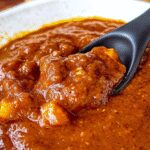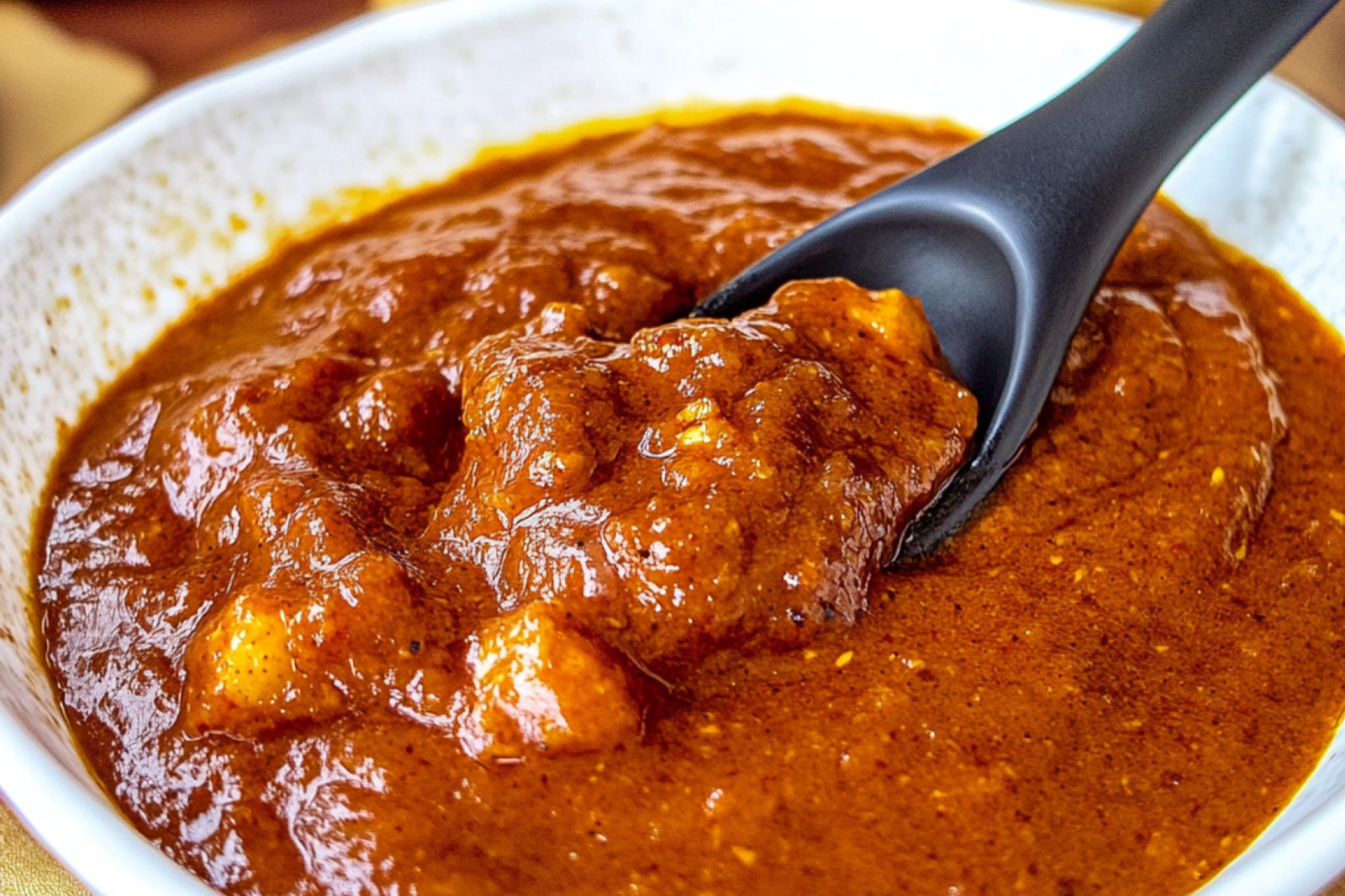The moment I tasted homemade guajillo sauce, my culinary world changed forever. This best guajillo sauce recipe transforms humble dried peppers into liquid gold that elevates everything it touches. Forget bland store-bought versions—within 30 minutes, you’ll create an authentic Mexican sauce with deep, complex flavors that will have everyone asking for your secret.
Whether drizzled over enchiladas, stirred into soups, or used as a marinade, this easy guajillo sauce recipe brings a touch of Mexican culinary magic to your kitchen. Not too spicy but packed with earthy, smoky goodness—this homemade classic strikes the perfect balance between accessibility and authentic flavor.
Why You’ll Love This Guajillo Sauce
✅ Ready in just 30 minutes with mostly hands-off cooking time
✅ Versatile base for countless Mexican dishes from enchiladas to tamales
✅ Perfectly balanced flavor with smoky, fruity notes and mild-medium heat
✅ Make ahead friendly – actually tastes better the next day!
✅ Freezes beautifully for quick weeknight flavor boosters
✅ Customizable heat level – easily adjust to your spice preference
✅ All-natural ingredients – no preservatives or artificial flavors
This authentic guajillo sauce recipe offers the best way to make guajillo sauce at home without specialty equipment or hard-to-find ingredients. It’s the quick and easy guajillo sauce recipe you’ll reach for time and again when you want to transform ordinary meals into something special.
Ingredients for Guajillo Sauce
For this best guajillo sauce recipe, gather these simple but essential ingredients:
For the Base:
- 8-10 dried guajillo chiles (about 2 oz/60g), stems and seeds removed
- 2 cups (480ml) chicken or vegetable broth (use vegetable for vegan option)
- 1 medium white onion, roughly chopped
- 3 garlic cloves, peeled
- 1 Roma tomato, quartered
- 1 tablespoon olive oil or neutral cooking oil
For the Seasonings:
- 1 teaspoon dried oregano (Mexican oregano preferred)
- ½ teaspoon ground cumin
- ¼ teaspoon ground cinnamon (optional but recommended)
- 1 teaspoon apple cider vinegar
- 1 teaspoon salt (adjust to taste)
- 1 teaspoon sugar (helps balance the flavors)
Substitutions & Variations:
- No guajillos? Use a mix of ancho and New Mexico chiles instead
- For extra richness: Add 1 tablespoon of tomato paste
- For smoky depth: Include 1 chipotle pepper in adobo sauce (will increase heat)
- Need it vegan? Use vegetable broth instead of chicken broth
- For tangier sauce: Add an extra teaspoon of vinegar or squeeze of lime juice
The must-have ingredients for guajillo sauce are definitely the dried guajillo peppers, as they provide the distinctive fruity, slightly smoky flavor that makes this sauce special. The best spices for guajillo sauce include oregano and cumin, which complement the peppers without overwhelming them.
How to Make Guajillo Sauce – Step by Step
Step 1: Prepare the Chiles
- Heat a dry skillet over medium heat.
- Toast guajillo chiles for 20-30 seconds per side until they become aromatic and slightly pliable. Be careful not to burn them.
- Transfer toasted chiles to a bowl.
- Pour hot water over them until completely submerged.
- Let soak for 15-20 minutes until soft and pliable.
📌 Pro Tip: For a more complex flavor, toast the whole cumin seeds before grinding and adding them to the sauce.
Step 2: Sauté the Aromatics
- In the same skillet, heat olive oil over medium heat.
- Add chopped onion and sauté for 3-4 minutes until translucent.
- Add garlic and cook for another 30 seconds until fragrant.
- Add tomato and cook for 2 minutes until slightly softened.
📌 Pro Tip: Don’t rush this step—properly sautéed aromatics build the foundation of flavor for your sauce.
Step 3: Blend the Sauce
- Drain the soaked guajillo chiles, reserving ½ cup of the soaking liquid.
- In a blender, combine:
- Soaked chiles
- Sautéed onion mixture
- Chicken or vegetable broth
- Reserved soaking liquid
- Oregano, cumin, and cinnamon
- Blend on high for 1-2 minutes until completely smooth.
📌 Pro Tip: For the silkiest texture, use a high-powered blender. If using a standard blender, you may need to blend longer.
Step 4: Strain the Sauce
- Place a fine-mesh strainer over a bowl.
- Pour the blended sauce through the strainer.
- Use a spatula to press and work the sauce through, extracting as much liquid as possible.
- Discard the solids left in the strainer.
📌 Pro Tip: Don’t skip straining! This crucial step ensures your guajillo sauce has that velvety restaurant-quality texture.
Step 5: Simmer to Perfection
- Transfer the strained sauce to a saucepan.
- Add salt, sugar, and vinegar.
- Bring to a gentle simmer over medium-low heat.
- Cook for 10-15 minutes, stirring occasionally, until slightly thickened.
- Taste and adjust seasonings as needed.
📌 Pro Tip: As the sauce simmers, it will darken slightly and develop a richer flavor profile. Be patient with this final step!
Pin For Later
Pro Tips for the Best Guajillo Sauce
Want to elevate your guajillo sauce from good to extraordinary? These professional tips will help you craft the most flavorful sauce possible:
Perfect Heat Level
- For milder sauce: Remove all seeds and membranes before soaking the chiles
- For medium heat: Keep some of the membranes intact while removing seeds
- For spicier sauce: Add 1-2 small dried árbol chiles to the mix
Texture Perfection
- Double-strain for the silkiest sauce possible
- Adjust thickness with additional broth if needed—the ideal consistency is similar to heavy cream
- If too thin: Simmer longer to reduce and concentrate flavors
- If too thick: Add broth, 1 tablespoon at a time
Flavor Boosters
- Toast your spices before adding them to the sauce
- Add a chocolate dimension with 1 teaspoon of unsweetened cocoa powder
- Deepen flavor with a splash of good-quality chicken bouillon
- Brighten with acid using fresh lime juice just before serving
Can you prepare guajillo sauce ahead of time? Absolutely! In fact, making this sauce 1-2 days in advance allows the flavors to meld and develop, resulting in an even more complex and delicious sauce.
What makes guajillo sauce extra special is the balance of earthy, fruity notes with a gentle warming heat—not overwhelming spiciness. This makes it accessible even for those who don’t tolerate extremely hot foods.
Best Ways to Serve Guajillo Sauce
The versatility of this best guajillo sauce recipe is truly impressive. Here are some delicious ways to use it:
As a Sauce For:
- Enchiladas: The most traditional use—creates restaurant-quality red enchiladas
- Chilaquiles: Pour over fried tortilla chips with eggs for a hearty breakfast
- Tacos: Drizzle over grilled meat or roasted vegetable tacos
- Burritos: Smother your next burrito for wet-style “burrito ahogado”
- Eggs: Transform simple scrambled eggs into a Mexican-inspired breakfast
As a Cooking Ingredient:
- Marinade: Perfect for chicken, pork, or shrimp
- Soup base: Add to chicken broth for an instant Mexican soup starter
- Rice flavor: Mix into rice while cooking for vibrant color and taste
- Stew starter: Use as the foundation for pozole or other Mexican stews
- Roasting sauce: Brush onto vegetables before roasting
The best way to serve guajillo sauce initially is with simple dishes where its complex flavor can shine. Try drizzling it over a quesadilla or using it to enhance a bowl of black beans and rice with a fried egg on top.
Nutritional Information
This homemade guajillo sauce isn’t just delicious—it’s also nutritious! Here’s the approximate nutritional breakdown per ¼ cup serving:
- Calories: 45
- Protein: 1g
- Carbohydrates: 6g
- Fiber: 1g
- Sugar: 2g
- Fat: 2g
- Sodium: 285mg
Guajillo chiles themselves are rich in vitamins A and C, plus antioxidants that support immune health. By making this sauce at home, you’re also avoiding the preservatives, excessive sodium, and artificial ingredients found in many store-bought versions.
Low-carb dieters: This sauce is naturally low in carbohydrates. For an even lower-carb version, omit the sugar completely.
Storage & Leftovers
One of the best things about this guajillo sauce is how well it keeps. Here’s how to store it properly:
How to store guajillo sauce leftovers:
- Refrigerator: Transfer cooled sauce to an airtight container. It will keep for up to 1 week. The sauce may thicken when chilled—simply thin with a little water when reheating.
- Freezer: For longer storage, freeze guajillo sauce in ice cube trays. Once frozen, transfer cubes to a freezer bag. This way, you can easily thaw just the amount you need. Frozen sauce maintains quality for up to 3 months.
- Reheating: The best way to reheat guajillo sauce is gently on the stovetop over medium-low heat, stirring occasionally. Microwave reheating works in 30-second intervals, stirring between each.
Can you can guajillo sauce for longer shelf life? Yes, but you’ll need to ensure proper acidification and follow safe canning practices. Adding an additional tablespoon of vinegar or lemon juice will help create the acidity needed for safe preservation.
4 FAQs About Guajillo Sauce
Can I freeze guajillo sauce?
Yes, guajillo sauce freezes exceptionally well! Pour cooled sauce into freezer-safe containers or ice cube trays, leaving some room for expansion. Frozen guajillo sauce maintains its quality for up to 3 months. Thaw overnight in the refrigerator or use the frozen cubes directly in hot dishes.
What’s the difference between guajillo sauce and enchilada sauce?
While guajillo sauce can be used as enchilada sauce, traditional enchilada sauce often contains a blend of different chilies. Guajillo sauce specifically features guajillo chiles as the star ingredient, giving it a distinctive fruity, slightly tangy flavor profile and moderate heat level. It’s generally more complex and authentically Mexican than generic enchilada sauce.
Can I substitute ancho chilies for guajillo?
Yes, ancho chilies make a good substitute for guajillo peppers, though the flavor profile will be slightly different. Anchos have a fruitier, raisin-like sweetness and milder heat. For the closest match, use a combination of ancho chilies with a small amount of cayenne pepper to replicate guajillo’s slightly higher heat level.
Why is my guajillo sauce bitter?
Bitterness in guajillo sauce typically comes from one of three issues: 1) burnt chilies during toasting (toast just until fragrant, not charred), 2) including too many seeds and membranes, or 3) not cooking the sauce long enough to mellow the flavors. If your sauce is already bitter, try adding a pinch more sugar or a small amount of honey to balance the flavor.
Conclusion: Your New Favorite Kitchen Staple
Once you’ve made this best guajillo sauce recipe, you’ll understand why it’s a cornerstone of authentic Mexican cooking. Its rich, complex flavor transforms ordinary ingredients into extraordinary meals with minimal effort. The balance of fruity, smoky notes with gentle warmth makes it accessible for all palates while remaining true to traditional flavors.
The beauty of this homemade guajillo sauce lies in its versatility and make-ahead convenience. Keep a batch in your refrigerator or freezer, and you’ll always be minutes away from a delicious meal with authentic Mexican character.
Have you tried making guajillo sauce before? What’s your favorite way to use it? Share your experiences in the comments below—I’d love to hear how this recipe works for you!
This best guajillo sauce recipe was developed after years of testing and perfecting techniques learned from traditional Mexican cooks. Enjoy the authentic flavor in your own kitchen!
Print
Guajillo Sauce: Flavorful Spice for Your Recipes
- Total Time: 30 minutes
- Yield: 2 cups 1x
- Diet: Gluten Free
Description
This best guajillo sauce recipe brings vibrant Mexican flavors to your kitchen with minimal effort. Made from dried guajillo chilies, this versatile sauce delivers a mild heat with sweet, fruity notes that transform any dish from ordinary to extraordinary.
Ingredients
- Dried guajillo chilies (8-10)
- 2 cups chicken or vegetable broth
- 3 garlic cloves
- 1/2 small onion
- 1 roma tomato
- 1 tablespoon olive oil
- 1 teaspoon dried oregano (preferably Mexican)
- 1/4 teaspoon ground cumin
- 1 teaspoon salt
- 1/2 teaspoon sugar
- 1 tablespoon apple cider vinegar
- Water as needed for consistency
Instructions
- Remove stems and seeds from the guajillo chilies. Tear or cut the chilies into large pieces. Heat a dry skillet over medium heat and toast the chilies for 1-2 minutes, turning frequently. Set aside.
- Heat olive oil in the same skillet. Add the chopped onion and sauté until translucent, about 3-4 minutes. Add the minced garlic and cook for another minute until fragrant. Add the diced tomato and cook for 2-3 minutes until softened.
- Add the toasted chilies to the skillet along with the chicken broth, oregano, cumin, salt, and sugar. Bring to a simmer, then reduce heat to low. Cover and cook for about 15 minutes until the chilies are soft and rehydrated.
- Transfer the mixture to a blender. Add the apple cider vinegar and blend until completely smooth, about 1-2 minutes. If the sauce is too thick, add water a tablespoon at a time until you reach your desired consistency.
- For an ultra-smooth sauce, strain the mixture through a fine-mesh sieve, pressing with a spoon to extract all the liquid. Return the sauce to the pan and simmer for another 5 minutes to meld flavors. Taste and adjust seasoning if needed.
Notes
- Store guajillo sauce in an airtight container in the refrigerator for up to 2 weeks.
- For longer-term storage, freeze in ice cube trays for convenient use.
- To reheat, warm gently on the stovetop and thin with water or broth if necessary.
- Prep Time: 10 minutes
- Cook Time: 20 minutes
- Category: Sauce
- Method: Blending
- Cuisine: Mexican
Nutrition
- Serving Size: 2 tablespoons
- Calories: 30
- Sugar: 2g
- Sodium: N/A
- Fat: 1g
- Saturated Fat: N/A
- Unsaturated Fat: N/A
- Trans Fat: N/A
- Carbohydrates: 5g
- Fiber: 1g
- Protein: 1g
- Cholesterol: N/A







